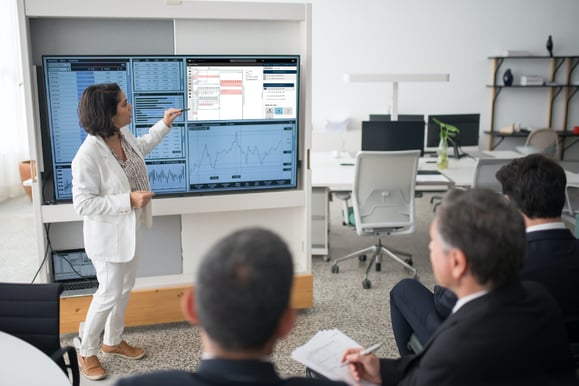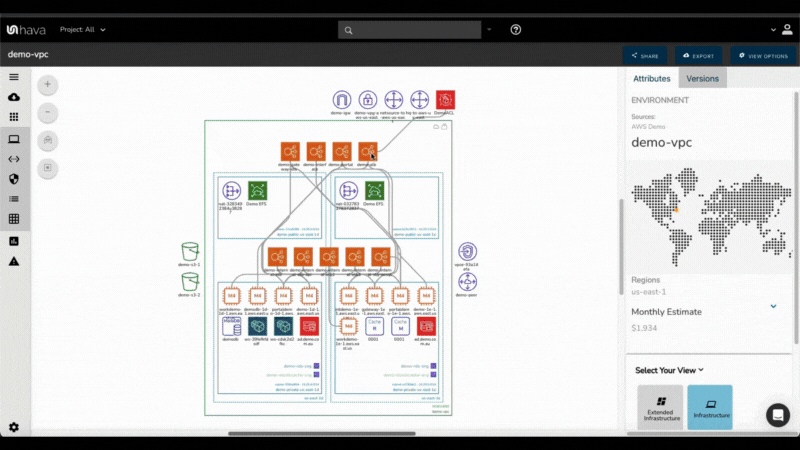Cloud I.T. Due Diligence for Start Ups
When you are chasing investors, a buyer for your business or merging with another company you are going to need detailed IT asset documentation....
Hava diagrams provide visibility into the security measures implemented within the system. Acquirers can evaluate how data is stored, encrypted, and protected within the cloud environment. Additionally, these diagrams aid in understanding if the system complies with relevant industry regulations, such as GDPR or HIPAA, ensuring that the software company has implemented appropriate security measures or comply with specific governance requirements like data geo-location.
Hava's cloud architecture diagrams allow acquirers to understand the integration points and dependencies with external systems or services. This analysis helps in evaluating the complexity of the system and identifying any potential risks or challenges during the integration process. Understanding these dependencies is crucial to ensure a smooth transition and minimize disruptions during the acquisition.
Both parties involved in the sale or acquisition of businesses, software applications, infrastructure, code or other IT systems that have a cloud based component can use Hava to clearly establish the state of that cloud infrastructure before, during and after a transaction.
Whether that transaction is acquiring a company, planning a merger, establishing a partnership agreement, designing a licencing agreement or a code merge, business owners can quickly leverage Hava to show the cloud position of either side quickly in a format that is clear, concise and easy to understand, even if they have never used Hava before.
Given the true nature of cloud and how often it changes the chances are the near impossible task of keeping cloud documentation up to date and in a state ready to hand over means the chances of that documentation being in place for due diligence are slim to none.
This is where Hava steps in, providing a way to visually inspect what a company is running in the cloud during the due diligence process.
There are a number of scenarios during an acquisition, merger or partnership agreement where the visibility provided by Hava can be invaluable.

When you need to show investors that what you have built has proper scalable cloud architecture and isn’t just a roadmap or vaporware under the covers, you can use Hava to map out your actual cloud architecture for inclusion in your decks or investor packs.
You use Hava to create the initial interactive diagrams of what is running in the cloud or multiple clouds. These diagrams can then be exported for inclusion as PNG or PDF in packs.
As you continue to evolve your cloud architecture and services, you can use Hava revision comparison diagrams to clearly show how your infrastructure has grown in response to the traction and delta of what has changed over time.
When you are being acquired, at some point during due diligence, you will be required to provide documentation related to your technology and IT assets.
In terms of your cloud assets, if you are already using Hava, you can simply export your current diagram sets for inclusion in the dd documentation or deal room.
If you are not using Hava to automate your cloud documentation and monitor changes, the vendor can easily complete this step of the cloud due diligence by plugging in Hava and auto generating the required documentation showing exactly what is running in their cloud architecture. There's now no excuse or hiding behind the "it's too complicated" or "you wouldn't understand the infrastructure as code"

Using Hava you can get a clear picture of exactly what is running in the cloud architecture you are acquiring. By requesting read only access or a cross-account role be added to the cloud accounts being used by the company you are looking to acquire, you can see exactly what is running.
From there you can make an informed decision on the stability, security and ultimately the validity of the value of the IT cloud asset. Hava really is the auditors due diligence friend!
When you are negotiating or entering into a partnership one of the primary considerations is establishing trust and in particular ensuring each partner can trust their potential partner’s IT cloud set up.
Whilst there are SOC2, ISO or other compliance certifications that will be shared as part of the due diligence process, it’s natural for tech companies to want to go deeper and validate the substance and scale of the cloud architecture they are partnering with. Will your partner’s cloud setup stand up to the level of performance and security expectations you have set for your own architecture.
Hava provides each party with clarity of what is running in each others architecture and gives you a visual and interactive way to be able to explore your prospective partner’s architecture without breaking anything.
If there are sensitive components in the architecture, Hava allows you to create a “custom view” of just the things you wish to reveal, even on the interactive diagrams.
Typically when a NBIO is triggered the purchaser will stipulate there should be no material changes made to IT systems, Customers, Sales etc
This ensures that the purchaser is receiving the cloud assets they have reviewed and agreed to proceed with.
Using Hava you can implement architectural monitoring which will trigger alerts when changes are made to the architecture. These alerts can be sent in real time to both parties. From there you can determine whether the change is material in nature or simply part of the normal scaling and operation of the application or architecture. Everyone is in the loop during the due diligence process which saves any nasty surprises cropping up at the end of the transaction potentially delaying settlement.
The due diligence process can often take months, so even though the initial test or review of the architecture has been completed, the changes that are made over the course of the due diligence time frame can be monitored by both parties with complete transparency.
If you are looking for a way to gain visibility on either side of a cloud asset transaction, let Hava be your IT System due diligence tracker.

Find out more about Hava's capabilities here:
When you are chasing investors, a buyer for your business or merging with another company you are going to need detailed IT asset documentation....
Disaster recovery cloud architecture diagrams save valuable time when assessing the impact and path forward during a disaster impacting your IT cloud...
Cloud architecture diagrams are an essential tool for clear communication between engineers and management. Retaining diagram versions amplifies...